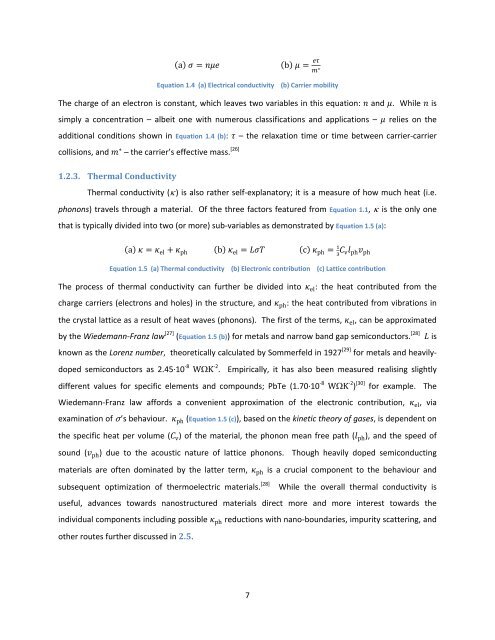Exploration and Optimization of Tellurium‐Based Thermoelectrics
Exploration and Optimization of Tellurium‐Based Thermoelectrics
Exploration and Optimization of Tellurium‐Based Thermoelectrics
Create successful ePaper yourself
Turn your PDF publications into a flip-book with our unique Google optimized e-Paper software.
a b <br />
∗<br />
Equation 1.4 (a) Electrical conductivity (b) Carrier mobility<br />
The charge <strong>of</strong> an electron is constant, which leaves two variables in this equation: <strong>and</strong> . While is<br />
simply a concentration – albeit one with numerous classifications <strong>and</strong> applications – relies on the<br />
additional conditions shown in Equation 1.4 (b): – the relaxation time or time between carrier‐carrier<br />
collisions, <strong>and</strong> ∗ – the carrier’s effective mass. [26]<br />
1.2.3. Thermal Conductivity<br />
Thermal conductivity () is also rather self‐explanatory; it is a measure <strong>of</strong> how much heat (i.e.<br />
phonons) travels through a material. Of the three factors featured from Equation 1.1, is the only one<br />
that is typically divided into two (or more) sub‐variables as demonstrated by Equation 1.5 (a):<br />
a el ph b el c ph <br />
v ph ph<br />
Equation 1.5 (a) Thermal conductivity (b) Electronic contribution (c) Lattice contribution<br />
The process <strong>of</strong> thermal conductivity can further be divided into el: the heat contributed from the<br />
charge carriers (electrons <strong>and</strong> holes) in the structure, <strong>and</strong> ph: the heat contributed from vibrations in<br />
the crystal lattice as a result <strong>of</strong> heat waves (phonons). The first <strong>of</strong> the terms, el, can be approximated<br />
by the Wiedemann‐Franz law [27] (Equation 1.5 (b)) for metals <strong>and</strong> narrow b<strong>and</strong> gap semiconductors. [28] is<br />
known as the Lorenz number, theoretically calculated by Sommerfeld in 1927 [29] for metals <strong>and</strong> heavily‐<br />
doped semiconductors as 2.45∙10 ‐8 WK ‐2 . Empirically, it has also been measured realising slightly<br />
different values for specific elements <strong>and</strong> compounds; PbTe (1.70∙10 ‐8 WK ‐2 ) [30] for example. The<br />
Wiedemann‐Franz law affords a convenient approximation <strong>of</strong> the electronic contribution, el, via<br />
examination <strong>of</strong> σ’s behaviour. ph (Equation 1.5 (c)), based on the kinetic theory <strong>of</strong> gases, is dependent on<br />
the specific heat per volume ( v) <strong>of</strong> the material, the phonon mean free path ( ph), <strong>and</strong> the speed <strong>of</strong><br />
sound ( ph) due to the acoustic nature <strong>of</strong> lattice phonons. Though heavily doped semiconducting<br />
materials are <strong>of</strong>ten dominated by the latter term, ph is a crucial component to the behaviour <strong>and</strong><br />
subsequent optimization <strong>of</strong> thermoelectric materials. [28] While the overall thermal conductivity is<br />
useful, advances towards nanostructured materials direct more <strong>and</strong> more interest towards the<br />
individual components including possible ph reductions with nano‐boundaries, impurity scattering, <strong>and</strong><br />
other routes further discussed in 2.5.<br />
7
















